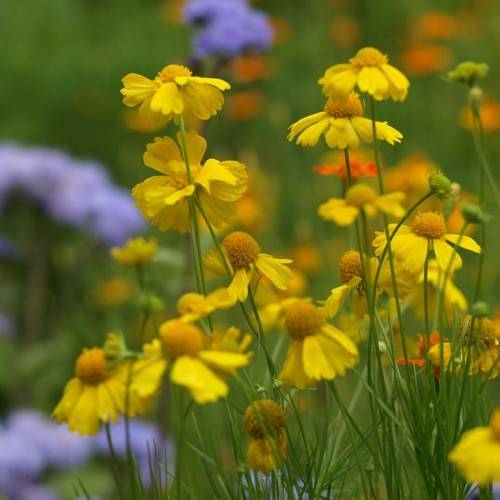
sneezeweed
Helenium amarum
Cycle:
Annual
Watering:
Minimum
Hardiness Zone:
3 - 10
Flowers:
Flowers
Sun:
Full sun,part shade
Leaf:
Yes
Growth Rate:
Low
Maintenance:
Low
Salt Tolerant:
Yes
Invasive:
Yes
Care Level:
Medium
watering
Sneezeweed should be watered every 1-2 weeks during the warmer spring and summer months, but it may require more frequent irrigation during extreme heat. Water thoroughly when the soil becomes dry to the touch. Make sure the soil drains properly, and avoid overwatering, as this could cause root rot. During the fall and winter months, water Sneezeweed only when the soil becomes very dry. It is best to water the soil around the base of the plant and not the leaves.
sunlight
Sneezeweed (Helenium amarum) is a plant species that prefers full sunlight. During the blooming season, provide at least 6 hours of direct sunlight each day. In a colder climate, this may increase to 8-10 hours per day. During the winter season, as days get shorter, the amount of sunlight will be reduced. Provide the plant with at least 4-5 hours of direct sunlight in order to provide the amount of light the plant needs to promote healthy growth.
pruning
Sneezeweed (Helenium amarum) should be lightly pruned throughout the growing season. Deadheading or cutting off spent flowers can encourage a new flush of blooms and keep the plant looking tidy. If the plant becomes unruly or overgrown, more extensive pruning can be done in early spring, just before new growth begins. This will remove any dead or weak stems and help the shrub maintain its shape. Avoid pruning too much in 1 season, as this may shock the plant.
Season
Hardiness Map
FAQ
Are Sneezeweed flowers suitable for bouquets?
Sneezeweed flowers are not typically used for bouquets due to their large size and bushy shape. The flowers are usually dried and used in other craft projects or for medicinal purposes. If you wanted to use dried Sneezeweed in your bouquet, they would provide a unique and eye-catching contrast against the other greenery in the bouquet.
Should Sneezeweed be planted in groups or individually?
Sneezeweed should be planted in groups, as groupings of this flower look the best in the garden. Planting them in groups will not only make them look more appealing but will also provide helpful cover for its shallow roots. Additionally, planting them in large groupings can help it to attract pollinators like butterflies and bees, providing a habitat where they can feed off the nectar-filled blooms. For best results, it's suggested to plant groupings of three to five plants for a lush, full look.
Is Sneezeweed resistant to deer damage?
Sneezeweed is a perennial flower with a resiliency to deer damage. It has a hairy leaf texture which deters deer from browsing on it and it produces a strong aroma that most deer tend to stay away from. The stems of the plant are also relatively tough, and not easily broken off. All in all, it is considered to be deer-resistant, but not completely deer-proof. It's important to monitor the plant to make sure it is not being overbrowsed and to take steps to protect it, if necessary.
Could Sneezeweed be grown as a cut flower crop?
Yes, sneezeweed can be grown as a cut flower crop. It is an attractive and abundant flower that has a daisy-like bloom. These flowers come in a variety of colors like yellow, orange, white, and burgundy. They are striking flowers with large, paper-like petals. They can be grown in full sun to partial shade and they prefer moist soil and regular watering. Sneezeweed flowers can be harvested for bouquets and other floral arrangements, and their cheerful blooms can brighten up any home or garden.
Do Sneezeweed plants require staking?
Sneezeweed plants do not typically require staking as they have quite sturdy stems that can easily hold their own weight. Depending on the size of the plant and the growing conditions, it is possible that staking may be needed to keep it upright. However, since the plant stems are so strong and rigid, it is typically not necessary.
Is Sneezeweed a good choice for erosion control?
Yes, Sneezeweed can be a good choice for erosion control. It is a vigorous, economical low maintenance plant with deep roots that make it ideal for quick soil stabilization and improved water quality. Its flat-topped blossoms provide cover for wildlife, making it a popular choice for natural areas. The plant's quick growth and large, thick foliage make it great for reducing erosion on slopes, shores, and other areas where fast-growing, hardy plants are desired.
Are there different varieties of sneezeweed?
Yes, there are different varieties of sneezeweed. Sneezeweed is a flowering plant in the daisy family, also known as Helenium. It produces yellow, red, orange, bronze and purple flowers from July to October. There are numerous species of sneezeweed; some of the most popular types are 'Mardi Gras', 'Autumnale', 'Red Rubin', 'Tahoka Daisy' and 'Kobold'. Each variety of sneezeweed is unique in its coloring, flower size and flowering period.
